Note: This process can become quite complicated. If it’s easier for you to follow along in video format, watch the videos in Section 6 of the First-Time Internet Marketing Profits™ video training.
I’ve briefly discussed Search Engine Optimization in previous lessons, but now it’s time to really delve into on-page SEO.
I’d like to point out that the following information is merely a summary of the essential concepts you need to know when starting out. A comprehensive discussion of on-page SEO requires a book of its own. This lesson is only meant to provide enough knowledge of the basics to start applying them to your website.
Why Learning On-Page SEO Is Necessary
On-page SEO is essential to be ranked highly in Search Engine Results Pages (SERPs). You want your pages to rank highly for the keywords you’re trying to rank so that more people will visit your website.
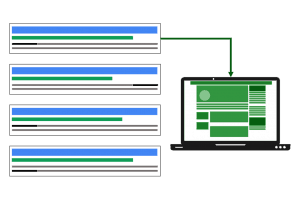
Given your limited time and resources, it’s only logical to try and optimize for the best and most widely used search engine out there. Even though the figures vary, Google is the undisputed leader in the search engine market (some statistics state 65%, while others state as high as 87%), so it’ll seem that we’re doing everything to please Google.
Which On-Page Activities For SEO to Focus On
VERY Important Note: Shortly before we published this training, WordPress dramatically redesigned their visual page and post editor, so your screens won’t quite match up with those in this training by default.
You can switch back to WordPress’ “classic editor” very easily, which will make all of your screens when drafting pages or posts on your website match up with those within this training.
Just search the internet using a phrase along the lines of “how to change back to WordPress classic editor” and you should be able to find multiple articles and videos that will walk you through this process step-by-step in less than five minutes.
The most important aspects of your article to insert your keyword into are the post title, meta title, meta description, and URL slug. Get your keyword in every single one of these elements and your post is as good as 80% optimized.
Every post needs a post title or headline. This is what your readers see when they click on the URL for your post on SERPs and when they read it.
I touched on the meta title and meta description in Lesson 29. These are elements that are shown on SERPs. Your meta title can be different from the actual post title, which I’ll show below.
I also discussed the URL slug briefly in a previous lesson. This is how your readers actually go into your post.
Other elements of your post to aim to use the keyword in are one other header (aside from your page title), image alt tags (when you can), and throughout your content (where appropriate).
I’ll show you what each one of these elements look like in WordPress, specifically in the Visual Editor and in the Yoast SEO plugin section.
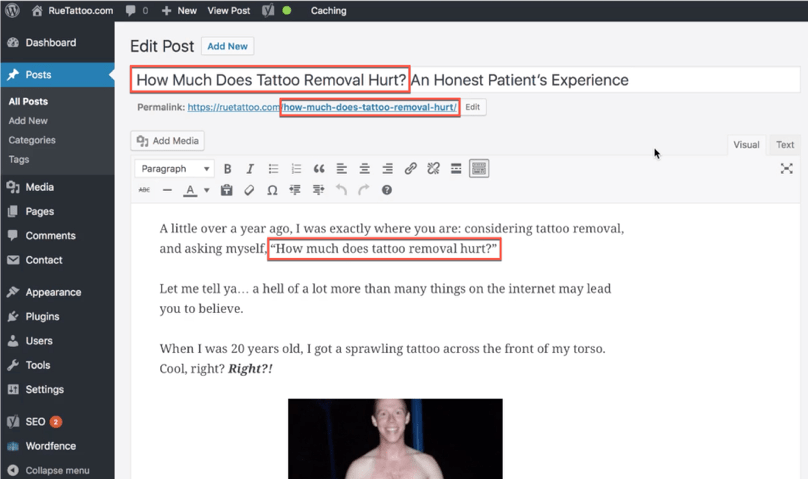
WordPress Dashboard, Posts, Add New, Add New Post, Visual Editor. Note that the Page Title at the top of the post (“How Much Does Tattoo Removal Hurt? An Honest Patient’s Experience”), the URL slug, also called the Permalink (https://ruetattoo.com/how-much-does-tattoo-removal-hurt/), and the first paragraph of the article all contain the focus keyword “how much does tattoo removal hurt.”
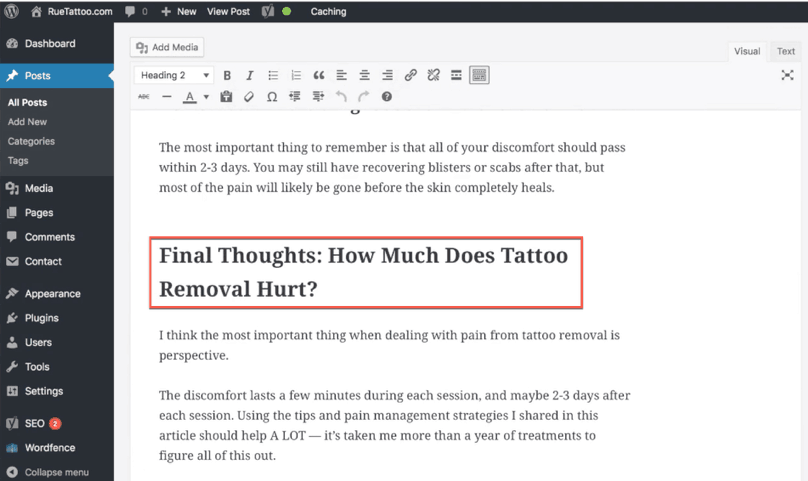
WordPress Dashboard, Posts, Add New, Add New Post, Visual Editor. Note that the Heading 2 subheader (“Final Thoughts: How Much Does Tattoo Removal Hurt?”) contains the focus keyword “how much does tattoo removal hurt?”
It’s good to include your focus keyword in one of the subheaders, but it can sometimes be difficult to do in a way that makes sense.
Pro Tip: Include the keyword in your conclusion subheader (e.g., “final thoughts,” “final words,” or simply “conclusion”).
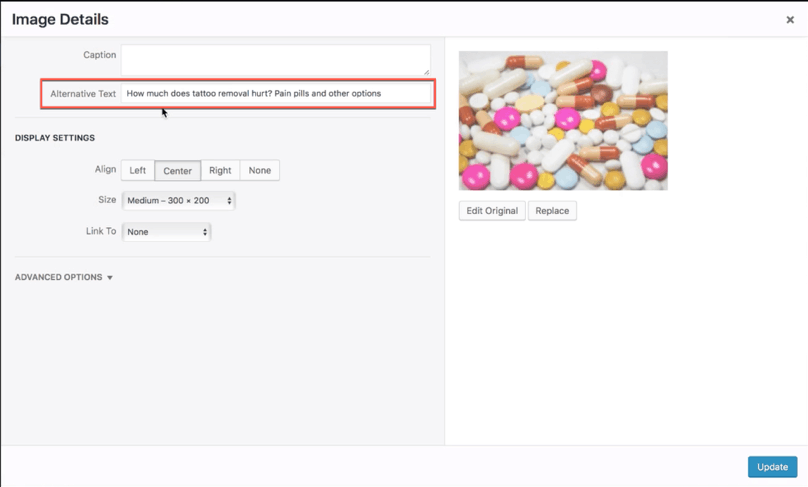
WordPress Dashboard, Posts, Add New, Add New Post, “Image Details” modal window. Note that “Alternative Text” (“How much does tattoo removal hurt? Pain pills and other options”) contains the focus keyword “how much does tattoo removal hurt.”
Another recommendation is to include your focus keyword in the alternative text, commonly known as the alt tag, of one of your images. The purpose of the alt tag is to describe the images placed on your site for the visually impaired. Their computer will read out this text and thus give them an idea of what your image contains.
The alt tag is also shown when image downloading is forbidden by a particular browser, or if a network connection is slow and images don’t load properly. You may have a bit of difficulty including your focus keyword in the alt tag in a way that makes sense. If this is the case, you can include it in the alt tag of your post’s featured image.
Yoast SEO Plugin
Yoast SEO is the best SEO plugin available, and it will make optimizing posts and pages for search engines much easier.
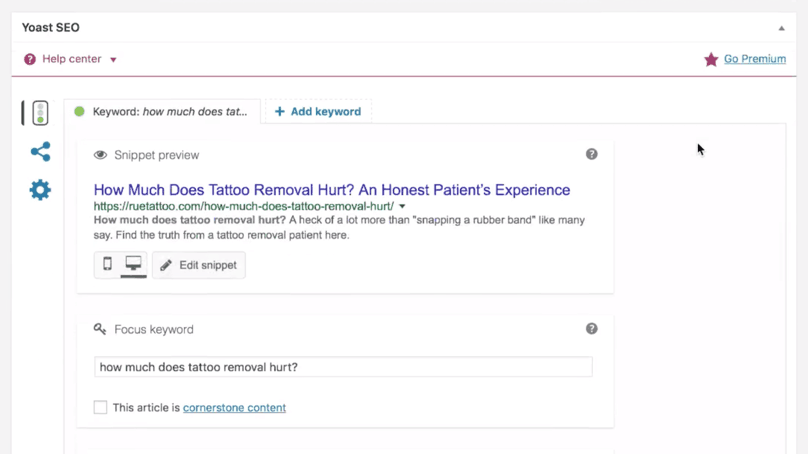
WordPress Dashboard, Posts, Add New, Add New Post, Yoast SEO. Note the meta title (“How Much Does Tattoo Removal Hurt? An Honest Patient’s Experience”), URL slug (https://ruetattoo.com/how-much-does-tattoo-removal-hurt/), and meta description (“How much does tattoo removal hurt? A heck of a lot more than ‘snapping a rubber band’ like many say. Find the truth from a tattoo removal patient here.”), as well as the “Focus keyword” field.
In WordPress, the meta title can be different from the post title, and you can edit both the meta title and meta description through the Yoast SEO section located below the Visual Editor.
The “Focus Keyword” field is where to enter the keyword you’re trying to optimize. Yoast SEO will then assess your post and determine whether the SEO for the post is good or needs improvement.
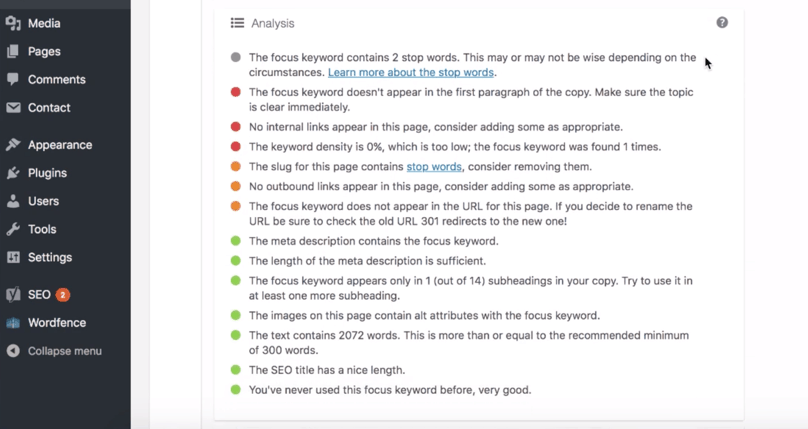
WordPress Dashboard, Posts, Add New, Add New Post, Yoast SEO Analysis
The “Analysis” section displays what has been done well, what has been done satisfactorily, and what needs to improve. These indicators point you in the right direction, especially for the major elements described earlier. However, take all of this insight with a grain of salt because Yoast SEO isn’t perfect.
From the image above, you can see that Yoast claims the focus keyword isn’t in the first paragraph, when I’m absolutely sure I put it there. Yoast also claims that my keyword density appears to be 0%. To be fair, the focus keyword (“How much does tattoo removal hurt?”) is difficult to naturally insert within a post. Keep in mind that you don’t need to place the exact keyword in your content if it doesn’t make sense to do so. It’s best to prioritize content quality over how many times the exact keyword is mentioned.
Contextual Keywords Matter
When using keywords in the body of your content, it’s important to remember not to use the exact phrase if it doesn’t make sense. Google’s algorithms have become sophisticated enough to recognize the context of a keyword. You can still rank in SERPs if the algorithms sense closely related phrases and synonyms of a keyword were used in the content.
However, this only works if you’re actually writing relevant, high-quality content around a focus keyword. If you’re not consciously inserting the keyword, you’ll tend to use phrases that are synonymous or contextually related. So, remember, if you’re truly producing high-quality content around a focus keyword, you’ll still manage to rank in SERPs even if the exact keyword isn’t used often throughout the content.
Let me explain with an example focus keyword I want to optimize: “how much does tattoo removal hurt.” I may only be able to use that exact phrase a few times throughout my post, so writing a high-quality article means I’ll use phrases like “tattoo removal hurts” or “pain management” or “pain relief.” Each of these contextual phrases, that are closely related to my focus keyword, are then picked up by Google. Google’s algorithms know those phrases are related to the keyword I optimized my post for.
The bottom line is that if you’re having trouble fitting an exact keyword in your post, then do your best to use close synonyms and related phrases instead so that your content doesn’t turn out robotic and off-putting.
Recommended Readings
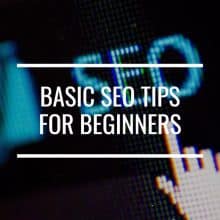
Basic SEO Tips For Beginners: On-Page Elements You NEED To Optimize
In this section of the article Basic SEO Tips For Beginners: How To Make Google Notice Your Content, I enumerate the critical on-page elements that you'll need to optimize.